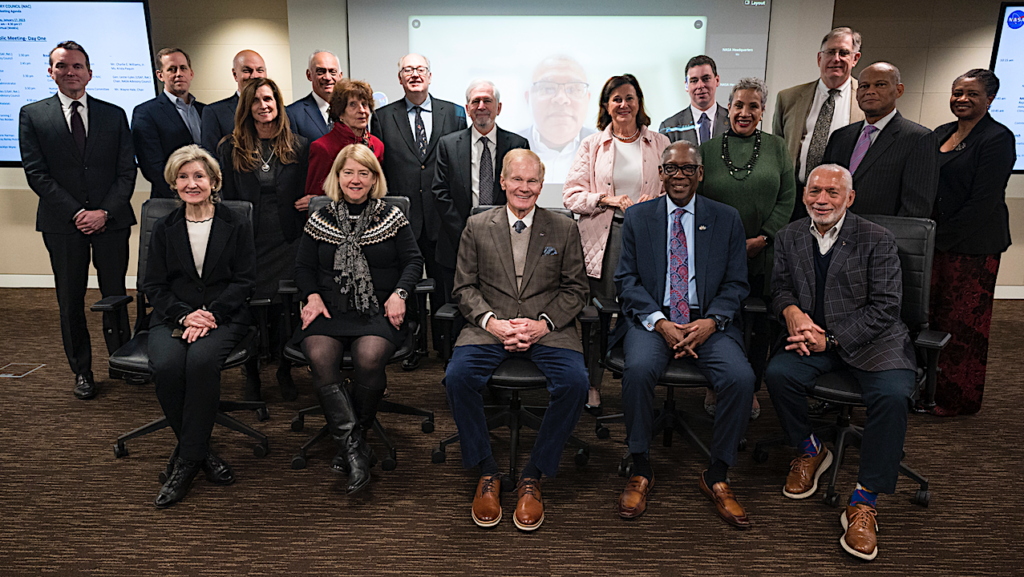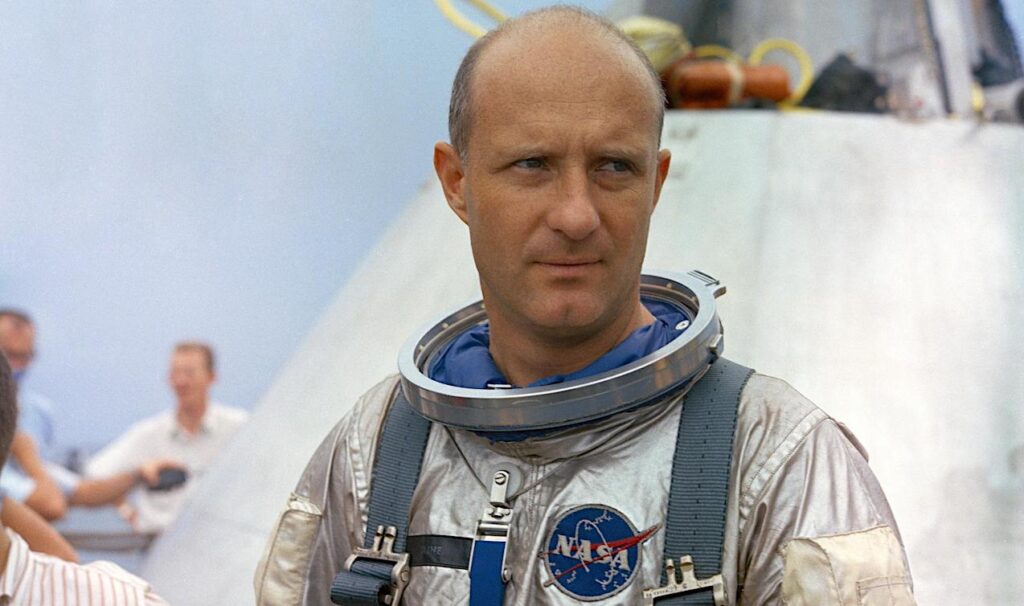Our Disjointed Space Exploration Strategy
#OTD 17 Dec 1903 Wright brothers conducted the first powered heavier-than-air sustained flight with a pilot. 74 yrs later the Voyager probes were launched. 118 yrs later these human-made machines are in interstellar space. Yet humans haven't stood on the Moon for half a century. pic.twitter.com/gf4mz5ztAz
— NASA Watch (@NASAWatch) December 17, 2021









Tolkien had it right. We’re always fighting the forces of darkness with no certainty we shall prevail but yet, by reason or purpose or faith, we must fight.
“I wish it need not have happened in my time,” said Frodo.
“So do I,” said Gandalf, “and so do all who live to see such times. But that is not for them to decide. All we have to decide is what to do with the time that is given us.”
BTW, reason, purpose, and faith are not de facto mutually exclusive.
Agree. It never hurt to possess all 3. After all, history belongs to those who are courageous. I’m in fact tired of seeing and hearing those optionate comments belittling others having a different rationale or approach in getting things done in the space community.
I grew up with the space program and for me Apollo happened during high school and college. For a long time I looked to NASA to establish the vision, the plan and to lead, especially in human space flight.
That all came to an abrupt end about 25 years ago. The NASA leadership since then has largely been corrupt, looking out for themselves. They have had no serious or commendable vision beyond self aggrandizement. They have not actually accomplished anything of significance. The closest they came was ISS but they short circuited the leadership and curtailed the program before it reached most of its goals.
I now no longer expect anything from NASA. I am hopeful that with Mr. Musk’s leadership humans will once again reach the Moon and then the planets.
Apollo program was done for political reasons. Since then there has been no reason to return people to the moon (something more convincing to others besides space hobbyists). Moon has become more interests such as next to walk the lunar surface be a person of color and/or woman (political reasons) or stepping stone to Mars (continuing myth of Mars colonies). Nobody talks about the moon except a few people advocating the economic development aspects. Likewise there is no reason to fly faster than subsonic. Most only ask of air travel it be on schedule and don’t lose luggage.
It is pretty obvious to anyone who has paid even a litle bit of attention, at least since Columbia, and probably back to Challenger; that is 35 years, that NASA manned space “leadership” has failed to lead.
Its been interesting to note the acclaim received by some who have left over this time; they were wonderful…friends…brilliant…the best we had…some were summarily dismissed to find top level industry jobs; some died. None managed a coherent program and none provided even a little bit of vision.
The evidence is all around us. An Orion and SLS that are too expensive and decades behind, and yet cannot do the job. A Gateway that is not obvious to anyone the long term value; most significant of all the willingness and encouragement to shut down programs having learned and applied not one iota.
Even more significant, is the capable NASA workforce that has been left to languish instead of having the opportunity to meet and achieve new challenges; they no longer even remember how they achieved the earlier challenges.
The long-term value of a Lagrangian Gateway properly designed & operated AS a genuine stepping-stone tech-pushing opportunity-enabling gateway (to the lunar surface, to other locations in cislunar space, and to locations about the inner solar system) is certainly obvious to a number of folks, including me.
The challenge (hopefully not insurmountable) would be to ensure that it IS properly designed & operated. History, sadly, does not inspire confidence here.
But as Chesterton said “Hope means hoping when things are hopeless, or it is no virtue at all.”
OK, go ahead and explain why a miniature Gateway station is a necessary thing. Why, when we’d rather be spending our limited budget on surface systems, or interplanetary systems, we’d rather spend it in weightessness, out in the middle of nowhere, just so an underpowered Orion would have a place to wait once every couple years during an ‘expedition’. Why, in an era of jumbo 100 person Starships cruising between Earth, Moon, and planets, we need a 5 person Gateway situated between worlds. Why, in an era after we’ve just spent $200 billion on an ISS that is now, ultimately a burden to maintain 200 miles away, we now need to spend a similar amount on a much smaller station, hundreds of thousands of miles away.
I intend to reply but been busy with Christmas prep (we’re hosting the extended gathering) and other urgent matters. It can’t be conveyed in a quick bumper-sticker phraseology…which admittedly is part of the broader problem/issue.
Merry Christmas Eve to All; I hope everybody gets at least some sleep!
Again, NK, sorry for the response delay.
I will use your last response (nay, challenge…) sentence by sentence to organize my presentation as what you list highlights most of the key arguments offered against a Gateway facility by, unfortunately, citing frequently voiced mischaracterizations (or bypassing) of the Gateway’s foundational purpose as well as misapplying unrelated circumstances to claim its lack of utility. [In other words, I fear you are disparaging something other than what actually is (so far) and especially that which I am speaking of regarding, as you said, a cislunar gateway’s long-term value. I can think of no better analogy here than what Venerable Fulton Sheen noted years ago: “There are not over a hundred people in the United States who hate the Catholic Church. There are millions, however, who hate what they wrongly believe to be the Catholic Church — which is, of course, quite a different thing.”]
But I first must re-emphasize what I said above in my initial response to your claim. For my part, I am speaking about the original functional intention of the Gateway as proposed by the NeXT/DPT efforts roundabout 2000 and which, I think, is still in the offing. That is, the convenient/optimized placement of a resources node flexibly designed to support multiple potential users traveling to and from various near and far locations by providing a variety of services. I fully admit there is unmistakably a very great danger (against which we must all be vigilant, loud, and most of all accurate in our warnings) that Gateway (the program) may (like far too many earlier NASA programs) morph into something more or different than what it should be.
Consider just its launch vehicle history: the original proposal had its components launched on multiple Delta IV Heavys. Then SLS came along (as you note, an idea 30 years beyond its best-potential utility), and now its first launch is slated to be on a Falcon Heavy. [That FH was selected (and that Space X won the first cargo resupply contract) gives me at least some hope that the original NeXT/DPT vision for Gateway might win out over the creeping vines of bureaucracy.]
But for your challenge sentences:
++++++++++++++++++++++++
OK, go ahead and explain why a miniature Gateway station is a necessary thing.
‘Miniature’ is an unnecessary and misleading characterization, no matter who uses it for whatever purpose. The facility ought to be as large as required to enable its functions at any given time, but this need not be a fixed parameter. What IS essential is that it be extensively modular so that it can expand as needed to accommodate both future servicing capabilities and any number of users.
‘Necessary’, too, is not an appropriate word here. It wasn’t necessary that all my surgeries took place in hospital operating rooms nor my chemo regimens be administered by trained medical professionals, but it was certainly beneficial that they did and were, respectively. There are multiple possible pathways to achieving goals in the field of space exploration and development. Musk’s vision may be a viable one, but not necessarily the best one. [Acknowledging, mind you, that ‘best’ is a very nebulous term entangled by numerous metrics of varying species.] The proper question to put forward is: What minimal assets will contribute the most leverage toward (hopefully most) efficiently achieving the broader vision of sustainable solar-system-wide spacefaring activities? Gateway, per its original conception, most definitely offers the potential to provide significant sustaining leverage to an array of stepping-stone and end-point space missions and endeavors; it was designed to do so.
Why, when we’d rather be spending our limited budget on surface systems, or interplanetary systems, we’d rather spend it in weightlessness, out in the middle of nowhere, just so an underpowered Orion would have a place to wait once every couple years during an ‘expedition’.
Your sentence entwines a number of (therein misconstrued) elements in a false either-or dichotomy. Gateway was conceived years prior to the birth of the Orion program, so your implication that Gateway is meant solely (‘just’) to support Orion (underpowered or not) is false.
[On a separate point, to suggest that Gateway serves merely as a parking space (for Orion or anything else) is a very narrow over-simplified rendering of the Artemis mission planning as well as the Gateway’s conception and role. But, I too wonder mightily what will unfold programmatically if/when Starship HLS and Orion meet in deep space… At the very least, I would hope it might prompt a serious reassessment of the Service Module’s propulsive capabilities.]
Spending a portion of our limited budget on a facility that will enable various users (not just Space X) to simplify lander, surface system, and interplanetary system designs is, by the very definition of the term, a stepping-stone toward advancement in space activities. More users with more potential methods of achieving goals means more opportunity for advancement and innovation. The ISS, for all its problems (like Shuttle with its limitations did before it), is enabling this very sort of supporting milieu (albeit in a more limited way) right now in LEO.
Consider Commercial Crew and its direct byproduct, Space X’s independent commercial Crew Dragon flights. Inspiration 4 unintentionally illustrated this very circumstance quite neatly. I4 lasted less than half a week for a reason; as impressive as it is, Dragon is a limited design. Yet even so it is able to stay on orbit as an ISS ferry vehicle (and lifeboat) for months because it can be docked to a facility rich in resources which Dragons do not sufficiently possess (if at all). Axiom’s long-term plans also illustrate this in-situ supportive capacity as well. Gateway is meant to offer such supportive capacity at a much more useful deep-space ‘location’, to a broader range of vehicles and missions heading to many other much- farther-afield ‘locations’.
Administrator Bridenstine tried to sum up this substantial enabling utility with his (unfortunately limited) analogy comparing Gateway to the Apollo Command Module. In its eventual availability to support lunar surface access, the analogy is okay as far as it goes. But Gateway is not solely meant to serve lunar surface missions. It is meant to support any spacecraft or mission which can benefit from the resources and services it can provide: from the mundane (e.g., attitude control, communications, power, non-propellant spacecraft deployments), to the more exotic (e.g., assembly of larger spacecraft—both cislunar and interplanetary), support of extended lunar surface operations (including base establishment) from its uniquely oriented low/high ‘polar’ lunar orbit).
Starship, your go-to solution, is envisioned as an all-in-one high-end combined-function ascent/entry/cruise spacecraft, in some ways not unlike Shuttle. Others who seek to reach the Moon (& beyond) with smaller budgets and lesser objectives might choose to separate their vehicle functionalities and thereby simplify their approaches. Such ‘lesser’ spacecraft (there are many out there today, and more envisioned) could benefit from a ‘service station’ closer (especially gravity-wise) to their intended destinations or operational locales. [Not many folks make cross-country road trips without partaking of offered services along the way.]
Your dismissal of ‘weightlessness’ as somehow unworthy and your disparaging ‘out in the middle of nowhere’ phrasing together suggest a limited appreciation of the numerous mission applications meant to be supported by Gateway and the specific history of the NRHO L1/L2-balanced halo orbit or even the more generic value of exploiting Lagrange-point celestial mechanics. Placing a resources/servicing support facility in a Lagrangian halo orbit offers relatively easy access to/from said resources and services (especially in terms of low required delta-V and burn-phasing flexibility) to a wide array of potential locations: cislunar space, the lunar surface, and locations beyond (including the Sun-Earth Lagrange points, asteroids, as well as Mars and its moons). See some of the links listed below.
The current nail-biting deployment of JWST serves to highlight one of Gateway’s original inspirations: future even larger telescopes or other spacecraft (built like Hubble—but unlike JWST—with in-space servicing in mind) might be assembled and/or unfolded in close Gateway proximity…and within EVA-intervention range, before being sent on their way to more distant locations. (You may remember that after launch one of Hubble’s solar arrays initially held up during deployment prompting EVA prep; the Compton GRO antenna did require EVA crew intervention.) Later, these same telescopes or spacecraft might regularly return for servicing, refueling, or hardware upgrades.
Why, in an era of jumbo 100 person Starships cruising between Earth, Moon, and planets, we need a 5 person Gateway situated between worlds.
I hate to break it to you, but we are NOT in an era of jumbo 100-person Starships cruising between Earth, Moon, and the planets, at least not for a few more years. So far only ONE crewless—I think it was even crew-cabinless) Starship prototype has successfully landed (and not blown up) following a ~10-km-altitude test flight. Perhaps we should wait for at least one successful land touchdown after an orbital flight before we declare that such an ‘era’ is upon us.
Don’t get me wrong; I’m very excited about Starship. I am also aware, however, that after the Boeing Dash-80 got in the air, all other aircraft did NOT become obsolete. It would be wise, I think, to do what we can to enable as many avenues of exploration, development, and especially innovation as is practically possible. This is part of Gateway’s purpose.
I personally am not confident that a sustainable space operations architecture can be achieved entirely with a ground-based approach; Earth’s deep gravity well (and climbing out of it, and descending back down into it through Earth’s atmosphere) imposes an awful lot of structural and technical overhead (not to mention wear & tear) upon every vehicle that must do so. Space engineers a long time ago came to appreciate the advantage and elegance of modular design; much is gained when the up/down solutions are distinct from the in-space solutions, AND when the point-to-point distances don’t always stretch all the way back down to a launch pad or pads on the Earth’s surface. Long-term reusable lunar landers, especially, and the entire regular mission plan sequencing of same, would benefit mightily from the landers being inspected, serviced, and refueled closer to the Moon. While this will eventually transition to a facility or facilities on the lunar surface, what of the interim? And non-landers, such as large telescopes, won’t have the option of descending to a nearby planetary et al surface for such eventual regular servicing.
As for being ‘situated between worlds’, does it not make sense to carefully build up our experience base in an environment in which we intend to conduct more and more activity but through which we’ve only thus far quickly transited and in which we’ve conducted but three EVAs? To successfully create a sustainable deep-space operations capability will almost inevitably require a longer-term and broader experience OF deep space. The temporary habitation capacity of Gateway will permit both short-term and long-term hands-on assessments of hardware, procedures, and crew in this environment while remaining relatively close to home, prior to committing to multi-million-mile journeys across the vast gulfs between planets. This too was part of Gateway’s original conception.
Why, in an era after we’ve just spent $200 billion on an ISS that is now, ultimately a burden to maintain 200 miles away, we now need to spend a similar amount on a much smaller station, hundreds of thousands of miles away.
I do not consider ISS ‘a burden’. It has untapped potential, surely, and it was & is more expensive than anyone wanted, but a burden? One could argue that carrying a child in one’s arms is a burden, too, but said burden comes with substantial benefits as well. Life is like that; so is pursuing any challenging activity. See the quote from Gandalf in the thread above about the time that is given us. As for the remainder of your sentence, see above in this response.
I would implore you to reconsider Gateway as the broad enabling opportunity that it can be and spend energy not on dismissing it out of hand but instead on defending its original intent and purpose against bureaucratic creep born of muddled thinking by…bureaucrats.
+++++++++++++++++++++++++++
Here are some links worth perusing:
https://history.nasa.gov/DP…
See especially pp. 8-9
A number of papers exploring the NRHO features and advantages:
https://ntrs.nasa.gov/citat…
https://engineering.purdue….
https://engineering.purdue….
https://ntrs.nasa.gov/citat…
https://ntrs.nasa.gov/citat…
A compendium of NeXT/DPT materials:
https://history.nasa.gov/DP…
Cheers!
On the other hand, we have all the world’s knowledge available in real time in our pockets and mRNA vaccines rapidly developing. It’s not a lack of progress, merely a different phase. Both are those would be as stunning – and perhaps less understandable – to the contemporaries of the Wright bros.
What would have seemed logical — almost inevitable! — back in Apollo days would have been for the US to builld a small lunar base, say for 3 or 4 asronauts on an occasional basis, gradually stepping up to say 12-20 astronauts occupying a larger base on a full time basis, with the intent of researching the technologies and resources required for self-sufficient space colonies. This would have been middling expensive — say 10 to 20 billion dollars added onto NASA’s “normal” 20 billion budget — and the immediate payoff would have been slim, but well affordable within a 20 trillion dollar GNP.
The sad fact is, neither Congress nor the White House nor the public at large has been willing to take that step, It’s been fifty years, and I have to conclude that this is a deliberate choice, nor likely to be changed with current political environment, that our government has basically decided that the US is NOT going to colonize space, nor seek to exploit its resourses.
For all the talk of American leadership, Humanity’s future in space would seem to lie on the shoulders of Elon Musk and China.